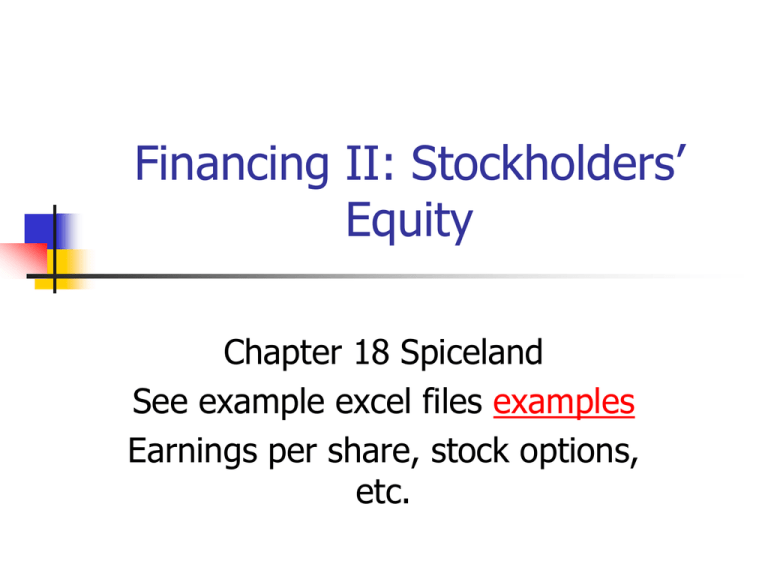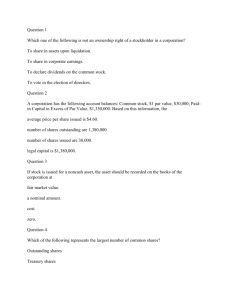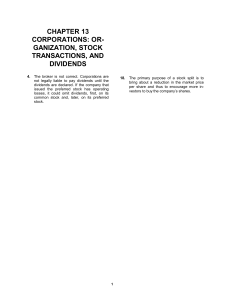Stockholders' Equity
advertisement

Financing II: Stockholders’ Equity Chapter 18 Spiceland See example excel files examples Earnings per share, stock options, etc. Topics: Types of stock Common Preferred treasury Issuance of stock Retained earnings Dividends Stock options Common Stock: Residual Owners’ equity Voting right (most important: election of directors) May or may not receive dividends May or may not have par value or stated value – depends on state corporate and tax law Common Stock Example: (Balance sheet presentation) Common stock $1 par ($500,000 shares authorized, 100,000 issued, 95,000 outstanding) Additional paid in capital $100,000 $900,000 Preferred Stock Characteristics High par value No voting rights Fixed dividends - Dividends cumulative Liquidation preference over common stock May be redeemable May be convertible Preferred Stock Example: Balance sheet presentation: Preferred stock, $100 par, 8% cumulative, convertible into 25 shares of common stock Issued and outstanding 2,000 shares $200,000 Treasury Stock: Stock repurchased by the company with the intent to reissue it in the future Reasons: Stock options Plan to acquire another company Buy out dissident stockholder Drive up stock price Prevent take over Treasury Stock: Contra stockholders’ equity account (debit balance) Usually carried at cost (may be at par value) Treasury Stock Example: 1. Company repurchases 1,000 shares @ $25/share Dr. treasury stock 25,000 Cr. Cash 25,000 2. 700 shares are sold @ 15/share (stock option exercise) Dr. Cash Dr. Additional paid in capital Cr. Treasury stock 10,500 7,000 17,500 Treasury Stock Example: Balance Sheet presentation: Common stock $1 par, 100,000 shares issued, 95,000 shares outstanding $100,000 Additional paid in capital $900,000 Less treasury stock, 5,000 shares at an average cost/share of $20 (100,000) Retained Earnings Ultimate residual owners’ equity account (ultimate plug figure) Sum of the earnings since the company started Minus the sum of dividends paid Plus/minus other adjustments Dividends Must be voted by the board of directors Dividends on preferred stock first, only then can common stock receive dividends! Cash dividends Dividends in kind Stock dividends Dividends Result in reduction of retained earnings Require expenditure of cash or other assets unless: Stock dividends – also referred to as “capitalization of earnings” Cash Dividends Journal Entry: 6/15 Dr. dividends $ Cr. dividends payable 6/30 Dr. dividends payable $ Cr. Cash 6/30 Dr. retained earnings $ Cr. Dividends 3,000 $ 3,000 3,000 $ 3,000 3,000 $ 3,000 B.S. Before Small Stock Dividend: Common stock $1 par ($500,000 shares authorized, 100,000 issued, 95,000 outstanding) Additional paid in capital Treasury stock 5,000 shares Retained Earnings Total Stockholders’ Equity $100,000 $900,000 (100,000) 1,200,000 2,100,000 Small Stock Dividend Journal Entry: 6/15 Dr. retained earnings $ 200,000 Cr. Common stock Cr. Paid in capital 10,000 190,000 (issued a 10% stock dividend = 10,000 shares, market price/share: $20) B. S. After Small Stock Dividend: Common stock $1 par ($500,000 shares authorized, 110,000 issued, $ 110,000 Additional paid in capital 1,090,000 Treasury stock 5,500 shares (100,000) Retained Earnings 1,000,000 Total Stockholders’ Equity 2,100,000 104,500 outstanding) Large Stock Dividend Journal Entry: 6/15 Dr. retained earnings $ 30,000 Cr. Common stock 30,000 (issued a 30% stock dividend = 30,000 shares, market price/share: $20) B. S. After Large Stock Dividend: Common stock $1 par ($500,000 shares authorized, 130,000 issued, $ 130,000 Additional paid in capital 900,000 Treasury stock 6,500 shares (100,000) Retained Earnings 1,170,000 Total Stockholders’ Equity 2,100,000 123,500 outstanding) Stock Split Very large stock dividend No journal entry, memo entry only to note new number of shares and new par value 2 for 1 stock split, new # of shares issued = 200,000, new par value: $ .50/share Balance Sheet After Stock Split: Common stock $ .50 par (1,000,000 shares authorized, 200,000 issued, $ 100,000 Additional paid in capital 900,000 Treasury stock 10,000 shares (100,000) Retained Earnings 1,200,000 Total Stockholders’ Equity 2,100,000 190,000 outstanding) Reverse Stock Split Market price of stock falls “too low” Companies sometimes try to improve the appearance or prevent delisting from a stock exchange by issuing a reverse split: I.e., for every 5 old shares stockholders receive 1 new share. Comprehensive Income Items whose market value (MV) has changed and that may affect equity but have not yet been realized Realized: Cash received (promise recognized) or paid (liability recognized) i.e., earned. Change in MV: E.g., MV of stock investments has in(de)creased Included in Comprehensive Income: Unrealized holding gains (losses) from Stock investments Changes (amendments) of post retirement benefit plans Foreign currency translation Derivatives Note: All items reported net of related tax effect. Reporting of Comprehensive Income Two possibilities: Right after net income (Income Statement) OR: Separate section in the footnotes. Again it starts with Net Income Ends with Comprehensive income for the period Accumulated Other Comprehensive Income (AOCI) Shown on the balance sheet (component of owners’ equity) Consists of as the heading says, all OCI (gains (losses) since company started to recognize it Quasi – Reorganization I A reorganization of the balance sheet generally in conjunction with a court adjudicated bankruptcy (Chapter 11) Objective: Fresh start for the company Revaluation (up or down) of assets (maybe liabilities) to market value Elimination of retained earnings deficit Quasi – Reorganization II Revalued Assets and liabilities Zero Retained Earnings Contributed Capital adjusted to balance This may require elimination of APIC and Reduction of common stock par value Quasi – Reorganization III Example: Before Assets 250 Liabilities 220 Common Stock 190 R/E -160 Total Equity 250 After 260 220 40 0 260







